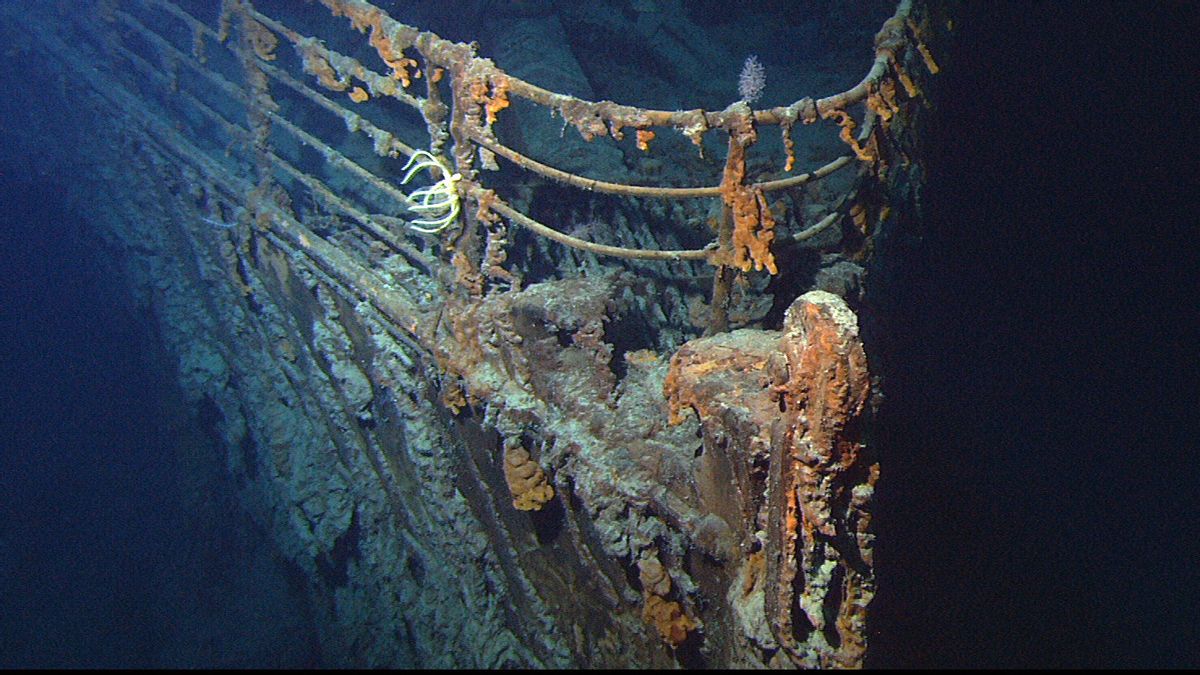JAKARTA - There was no feeling at that starless night. All ship passengers are doing their normal activities. All enjoyed their maiden voyage on a super passenger ship taking them from Southampton, England to New York, United States. Titanic, a legendary and luxurious ship that supposedly could not sink.
But that confidence seems to be starting to be tested. This enthusiastic journey suddenly changes when it is 11:40 p.m., today April 14, more than a century ago or 1912. The crew missed. Suddenly the crew saw an iceberg mound which was only 500 meters in front of the ship.
Even though the steering wheel slammed quickly, the incident could not be avoided. The iceberg still had time to kiss the back of the ship. Some parts started to have holes. Water also flooded the ship in several spaces.
Citing The Journal, when the Titanic sank in about two and a half hours. The incident that took place in the North Atlantic Ocean claimed 1,514 lives.

The sinking of the Titanic was arguably very dramatic and sudden. The reason is, the creator is studded with the luxury ship that nothing can sink, including God, if you refer to the dialogue version of the film by James Cameron.
Time and time again, a number of characters have said this. "Even God will not be able to sink this ship," said Caledon Hockley, played by Billy Zane, just before boarding the ship. The dialogue was also spoken by other characters, Captain Smith (Bernard Hill) and the Titanic creator himself, Thomas Andrew (Victor Garber).
The narrative was not playing games by James Cameron. In various theories, the Titanic was called a ship not only luxurious, but also very strong because of its perfect construction. This perfection also triggered a long and yearly search to explore how the accident happened and how the supposedly perfect ship sank.
Iceberg problem
However, that theory only applies within the factory. In the oceans, the true home of the universe, other theories have sprung up. One of them was about 1912 which was called the year when the icebergs were extraordinarily large.
The extreme tides on the Greenland Coast perpetuate this theory. Indeed, ships that traveled through the Atlantic Ocean in the time before the Titanic incident occurred exchanging reports of the presence of a number of icebergs.

After the Titanic incident, the International Ice Patrol was formed to monitor the danger of ice and alert ships in the northwest Atlantic. One way they measure danger is by reporting the number of icebergs seen at the point of latitude extending to the Atlantic from southern Newfoundland.
In 1912 alone there were 1,038 icebergs crossing this latitude. However, prior to Titanic, no fatal accidents occurred, although the risk of the ship crashing into an iceberg in 1912 cannot be ignored.
Origin of the Titanic iceberg
The old view states, the iceberg in the Atlantic Ocean that collided with the Titanic came from a glacier carried by ocean currents. It was not stated exactly which part of the glacier was carried away there.
Afterward, the iceberg drifts south along the East Greenland Coast and then north on the West Greenland Coast, then circles Baffin Bay and heads south along Labrador Beach, before finally reaching the Atlantic Ocean shipping lanes.
In fact, there is no definite way of telling from which point the long journey of the iceberg that suddenly appeared at night and then disappeared after colliding with the Titanic. But, at least the Professor of Earth System Sciences from Shellield University Grant Bigg, through his writing on The Conversation, explains a more sophisticated and precise model for mapping where these icebergs come from taking into account wind and time.
As a result, it is highly probable that the iceberg that hit Titanic was cut off from the glaciers at the southwestern tip of Greenland during the late summer or early autumn of 1911. The icebergs, Bigg said, took a more direct route across the North Labrador Sea and then met the ship.
This certainly defies the previous argument that the iceberg crosses several sea lines. Moreover, the modeling is strengthened by data from direct observation.
Therefore, Bigg also matches the description of the iceberg of the ship's victims. According to Bigg, the data supports the modeling he makes. This means that it is likely that the iceberg originated in southwest Greenland.
The English, Chinese, Japanese, Arabic, and French versions are automatically generated by the AI. So there may still be inaccuracies in translating, please always see Indonesian as our main language. (system supported by DigitalSiber.id)













